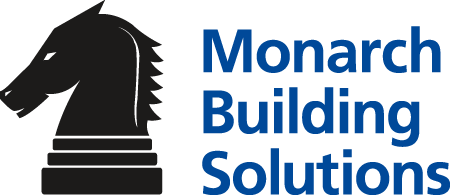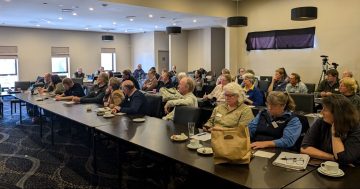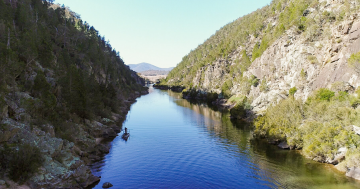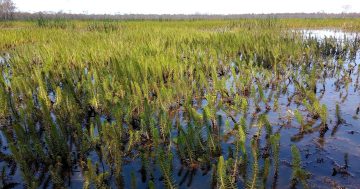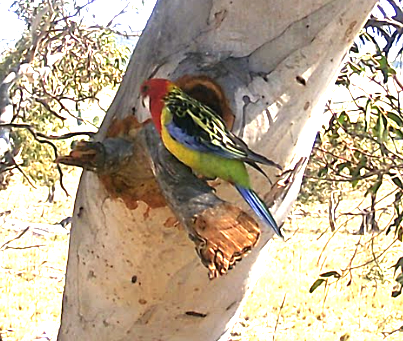
An eastern rosella checking out the hollow created by the Hollowhog tree boring tool. Photo: Upper Snowy Landcare Network.
Upper Snowy Landcare Network has two conservation projects underway that use cutting-edge technologies.
The first uses a new wood/tree boring technology to fast-track the 100-year process of forming the hollows that wildlife need to breed.
The second project uses an app to augment recent tree planting with under-storey plants that closely replicate what would have normally occurred prior to clearing.
Snowy Hydro is funding both projects. Work began in June 2024 and the funding must be acquitted by June 2025.
Over the past 20 years a 2000-sqkm area in the Snowy Monaro Regional Council area has lost a huge amount of healthy large- and medium-sized ribbon gums.
Since 2016, with the help of grant funding from several places, Upper Snowy Landcare Network has strategically placed 50 one-hectare biodiversity plots with mixed trees in the tree die-back area. Some trees now stand five metres tall or more.
There was no science behind it, but an app developed by the NSW Government is changing that. The Trees Near Me app describes plant community types across the state.
The Snowy Monaro area has 112 plant community types.
Upper Snowy Landcare Network project manager Lauren Van Dyke said the app told users what plant community types they were on, the pre-clearing community, and what was left.
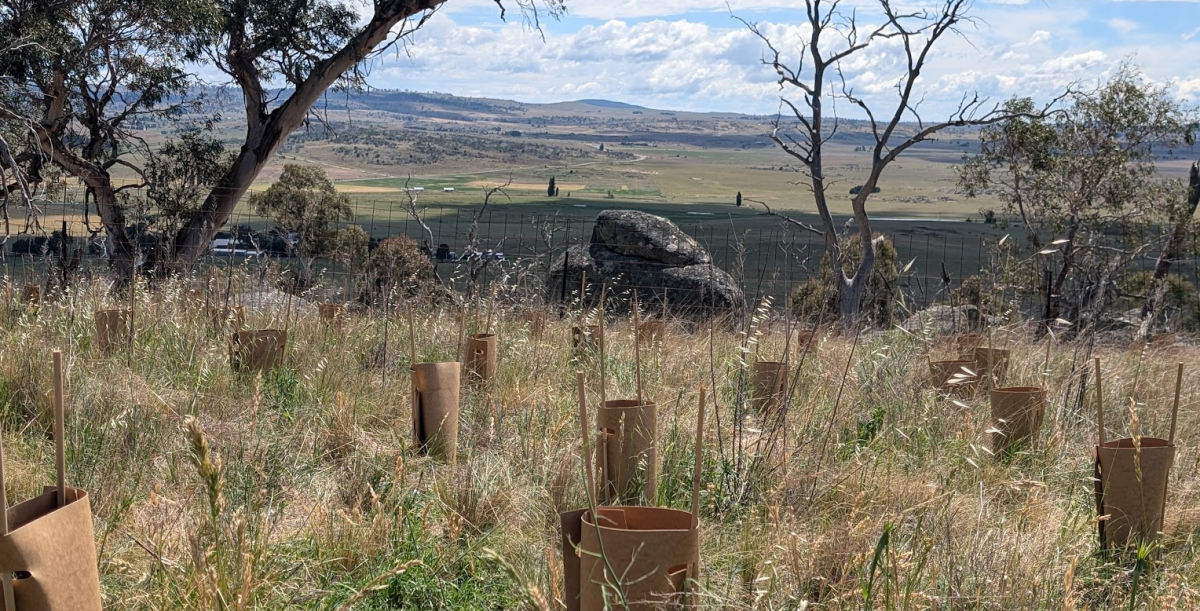
New plants added to die-back affected planting sites to restore landscape to the original Monaro Gourock Frost Hollow Grassy Woodland plant community type. Photo: Upper Snowy Landcare Network.
She said the government developed the app by using a large range of scenarios and modelling based on the geology and historical information before the massive clearing began.
“It is pretty amazing and close to the mark,” she said.
Upper Snowy Landcare Network approached Snowy Hydro with the idea of returning to three of their biodiversity plots to infill with plants that would have naturally occurred.
“The main idea we were working on is to promote biodiversity,” Ms Van Dyke said. “We have a record of what was there before and wanted to open that up to a suite of plants, ground cover and shrubs, so that we are building more robust environmental spaces.”
The $25,0000 project funded Wagtail Natives Nursery in Berridale to grow 900 local but less common mid- and ground-storey native plant species.
Matt Stephens, a NSW ecologist, designed the Hollowhog in 2023 to create hollows for birds and small arboreal species.
Ms Van Dyke saw it on television and learnt of a contractor who had bought one and been trained to use it.
“He came down our way and said this would be a good place to trial it,” Ms Van Dyke said. “We thought we would put the $9500 Snowy Hydro grant money towards as many hollows in the Gegedzerick Travelling Stock Reserve as we could.”
Upper Snowy Landcare Network leases a part of the stock reserve to do project work, just as farmers lease sections of it for their own purposes.
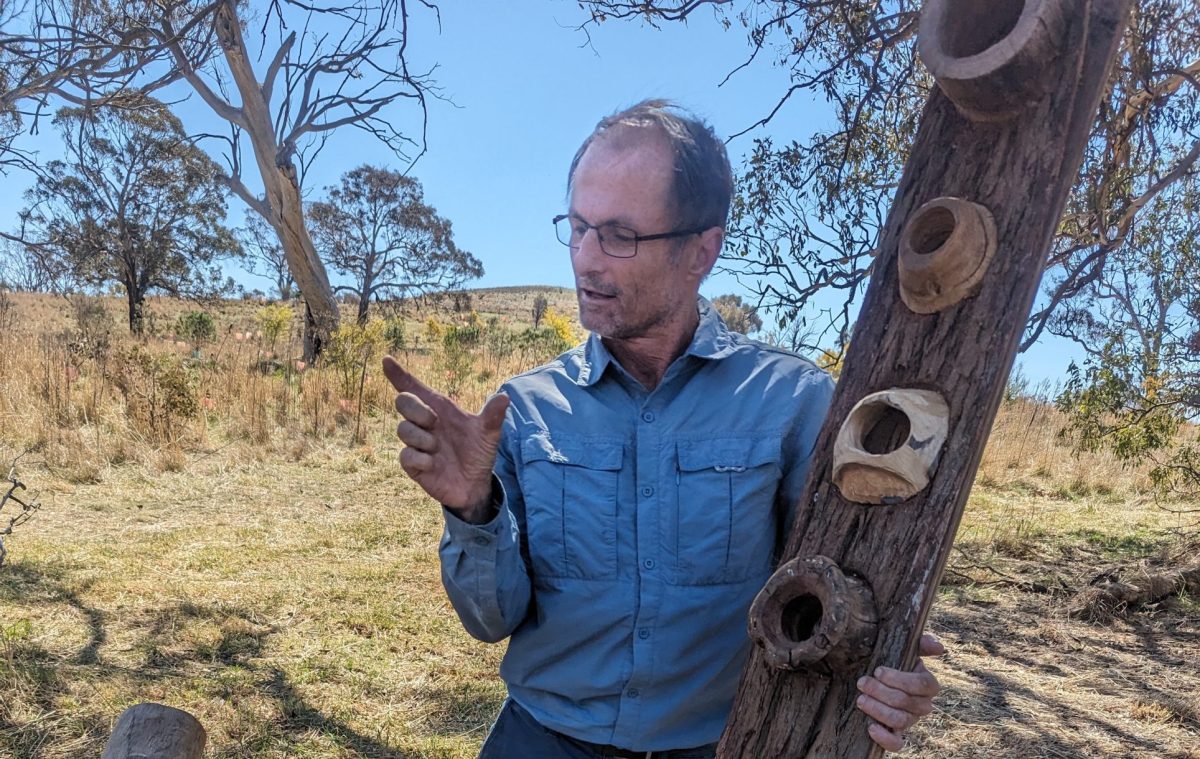
Sydney-based ecologist Matt Stephens who designed the Hollowhog tree boring tool. Photo: Upper Snowy Landcare Network.
The group is targeting the gang gang cockatoo and brown treecreeper. Both are threatened birds that require hollows.
The contractor researched the hollows those two species use – how high the hollows are in the tree, the shape and size of the opening, and the shape and size of the interior.
Upper Snowy Landcare Network also engaged an arborist to assure Snowy Hydro that no trees would be harmed by the Hollowhog tool. The arborist and contractor selected 30 suitable trees in Berridale in the reserve.
Ms Van Dyke said vast amounts of habitat had been lost in 150 years of clearing.
“It takes the hollow 80 to 120 years to form so we have had this big gap where animals, birds and lizards haven’t had these hollows to breed so therefore their numbers are low,” she said.
“If we can fast-track the hollow-forming process by using this tool and target species we would like to encourage, then we can do some really good work.”
They have installed cameras nearby which have captured crimson rosellas and eastern rosellas putting their heads into the new hollows and entering them.
Unfortunately, starlings are also showing interest “so we have to come up with a way to repel our feral birds”, Ms Van Dyke said.
She said Mr Stephens had created hundreds of hollows in Sydney where he lived.
“We are calling it a trial because no one has done it down our way,” she said.
“This is huge if it works and we feel it will because it has already been trialled in other parts of Australia,” Ms Van Dyke said. “Any other environmental manager should be entertaining this idea. It seems a no-brainer.”





